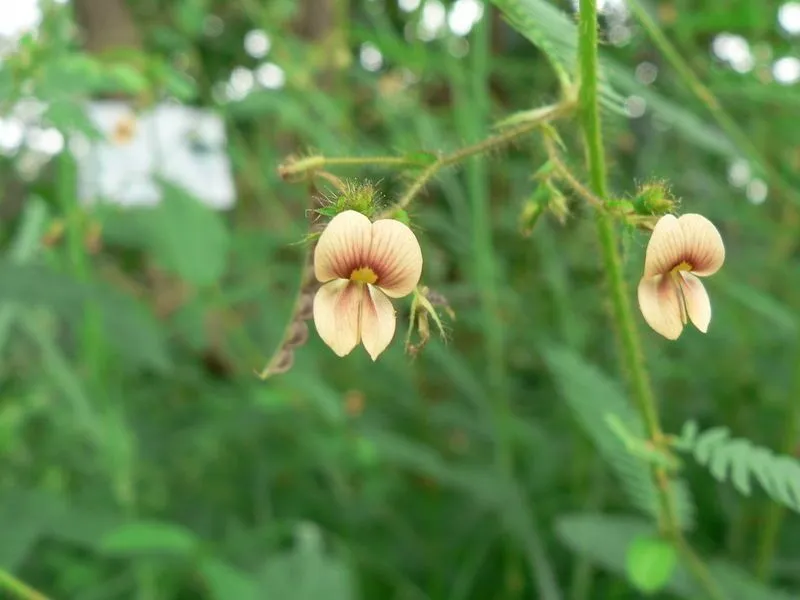
Author: L.
Bibliography: Sp. Pl.: 713 (1753)
Year: 1753
Status: accepted
Rank: species
Genus: Aeschynomene
Vegetable: Unknown
Observations: Trop. & Subtrop. Old World
Curly-indigo, known scientifically as Aeschynomene indica, is a fascinating member of the Fabaceae family. This plant has a rich history and vivid presence, first described in 1753. The genus name, Aeschynomene, is derived from the Greek words “aeschyne” meaning “shame” and “mene” meaning “moon,” reflecting the sensitive nature of the plant’s leaves which may fold under certain conditions.
Curly-indigo is native to the tropical and subtropical regions of the Old World, flourishing in a variety of habitats across Africa, Asia, and the islands of the Indian Ocean. It is particularly well-adapted to wetlands and often found in areas with moist, clayey soils where it can thrive.
Morphologically, Curly-indigo is a herbaceous plant that can grow into an erect or sprawling form, typically reaching up to 1.5 meters in height. The leaves are pinnate, featuring numerous small, oblong leaflets that exhibit nyctinasty—an interesting phenomenon where the leaves close at night or under the influence of certain stimuli. The plant’s inflorescence is quite distinctive, with clusters of small, yellow flowers that bloom throughout much of the year, making it a visually striking plant in its natural habitat.
An important aspect of Aeschynomene indica is its agricultural value. The plant is often used as green manure and cover crop due to its ability to fix nitrogen in the soil, significantly boosting fertility and benefiting subsequent crops. Its robust growth also helps in preventing soil erosion, making it an eco-friendly choice for sustainable farming practices.
Moreover, Curly-indigo has various traditional uses in herbal medicine. Extracts from its roots and leaves have been utilized to treat a range of ailments, showcasing the plant’s versatility beyond its ecological contributions.
In summary, Aeschynomene indica, or Curly-indigo, is much more than just a plant; it is a testament to nature’s ingenuity, contributing to both ecological balance and agricultural productivity. Its adaptability and benefits underscore the importance of preserving such species and understanding their role within our ecosystems.
Eng: indian joint-vetch, indian jointvetch, budda-pea, curly-indigo, hard sola, jointvetch, kat sola, northern joint-vetch, sensitive joint-vetch
Deu: indische schampflanze
Por: angiquinho
Jpn: kusanemu
En: Curly-indigo, Northern joint-vetch, Hard sola, Sensitive joint-vetch, Budda-pea, Indian joint-vetch, Kat sola, Indian jointvetch, Jointvetch, Sensitive Vetch
Zh: 合萌, 山岩黃耆
Fr: Nélitte d’Inde
De: Indische Schampflanze
Ja: Kusanemu
Ko: 자귀풀
Ml: നെല്ലിത്താളി
Pt: Angiquinho
Pt-br: Papquinha, Pinheirinho, Maricazinho, Angiquinho
Zh-tw: 合萌
© copyright of the Board of Trustees of the Royal Botanic Gardens, Kew.
© copyright of the Board of Trustees of the Royal Botanic Gardens, Kew.
© copyright of the Board of Trustees of the Royal Botanic Gardens, Kew.
Taken Jan 7, 2022 by Maarten Vanhove (cc-by-sa)
Taken Jan 8, 2022 by Maarten Vanhove (cc-by-sa)
Taken Jan 26, 2020 by prithvijit (cc-by-sa)
Taken Jan 1, 1900 by EOL − Günter Baumann (cc-by-nc-sa)
Taken Jan 7, 2022 by Maarten Vanhove (cc-by-sa)
Taken Jan 26, 2020 by prithvijit (cc-by-sa)
Taken Jan 1, 1900 by EOL − Bart Wursten (cc-by-nc)
Taken Jan 1, 1900 by EOL − Bart Wursten (cc-by-nc)
Taken May 24, 2021 by Fernando da Luz Schmidt (cc-by-sa)
Taken Jan 7, 2022 by Maarten Vanhove (cc-by-sa)
Taken Jan 31, 2021 by prithvijit (cc-by-sa)
Taken Jul 27, 2022 by Gowhar shapoo (cc-by-sa)
Taken Nov 27, 2021 by Margaret Bassey (cc-by-sa)
Taken May 24, 2021 by Fernando da Luz Schmidt (cc-by-sa)
Taken Jan 7, 2022 by Maarten Vanhove (cc-by-sa)
Taken Jan 8, 2022 by Maarten Vanhove (cc-by-sa)
Family: Myrtaceae Author: (F.Muell.) K.D.Hill & L.A.S.Johnson Bibliography: Telopea 6: 402 (1995) Year: 1995 Status:…
Family: Rubiaceae Author: Pierre ex A.Froehner Bibliography: Notizbl. Bot. Gart. Berlin-Dahlem 1: 237 (1897) Year:…
Family: Sapindaceae Author: Koidz. Bibliography: J. Coll. Sci. Imp. Univ. Tokyo 32(1): 38 (1911) Year:…
Family: Asteraceae Author: A.Gray Bibliography: Pacif. Railr. Rep.: 107 (1857) Year: 1857 Status: accepted Rank:…
Family: Fabaceae Author: Medik. Bibliography: Vorles. Churpfälz. Phys.-Ökon. Ges. 2: 398 (1787) Year: 1787 Status:…
Family: Aspleniaceae Author: (Cav.) Alston Bibliography: Bull. Misc. Inform. Kew 1932: 309 (1932) Year: 1932…